K-Means
In Part 3 of this series we showed how to write a simple distributed implementation of Map-Reduce using Cloud Haskell. In this final part of the series we will explain the K-Means algorithm and show how it can be implemented in terms of Map-Reduce.
K-Means is an algorithm to partition a set of points into n clusters. The algorithm iterates the following two steps for a fixed number of times (or until convergence):
- Given a set of points and n cluster centres, associate each point with the cluster centre it is nearest to.
- Compute the centre of each new cluster.
The initial cluster centres can be chosen randomly. Here is one example run of the first 5 iterations of the algorithm on randomly (evenly) distributed two-dimensional points:
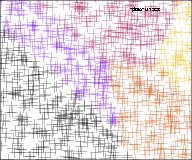
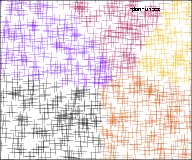
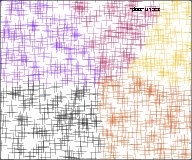
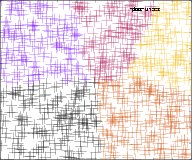
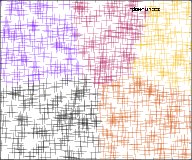
Of course, in such an evenly distributed data set the clusters that are "discovered" are more or less arbitrary and heavily influenced by the choice of initial centers. For example, here is another run of the algorithm with different initial centers:
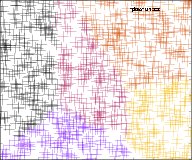
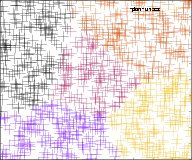
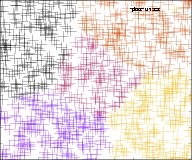
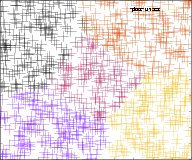
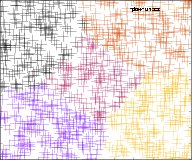
K-Means as a Map-Reduce skeleton
We will use Map-Reduce to implement a single iteration of the K-Means algorithm. Each mapper node will execute step (1) of the algorithm for a subset of the points, and in the reduction step we will compute the new cluster centres.
type Point = (Double, Double)
type Cluster = (Double, Double)
average :: Fractional a => [a] -> a
average xs = sum xs / fromIntegral (length xs)
distanceSq :: Point -> Point -> Double
distanceSq (x1, y1) (x2, y2) = a * a + b * b
where
a = x2 - x1
b = y2 - y1
nearest :: Point -> [Cluster] -> Cluster
nearest p = minimumBy (compare `on` distanceSq p)
center :: [Point] -> Point
center ps = let (xs, ys) = unzip ps in (average xs, average ys)
kmeans :: Array Int Point -> MapReduce (Int, Int) [Cluster] Cluster Point ([Point], Point)
kmeans points = MapReduce {
mrMap = \(lo, hi) cs -> [ let p = points ! i in (nearest p cs, p)
| i <- [lo .. hi]
]
, mrReduce = \_ ps -> (ps, center ps)
}
We start with a Map (Int, Int) [Cluster]; the keys in this map correspond to
the segmentation of the input set; for instance, a key (20, 39) indicates
that a mapper node should compute clusters for points [20 .. 39]. The values
in this map are the current center (that is, every key in the map has the same
value).
The mappers then compute a list [(Cluster, Point)] which associates points
with each cluster. Finally, in the reduction step we create a Map Cluster
([Point], Point) which tells us for each cluster its set of points and its
centre.
Iterating locally
The Map-Reduce skeleton only computes a single iteration of the algorithm; we
need to iterate this a number of steps to implement the full algorithm. Using
the localMapReduce we defined above we can do this as
localKMeans :: Array Int Point
-> [Cluster]
-> Int
-> Map Cluster ([Point], Point)
localKMeans points cs iterations = go (iterations - 1)
where
mr :: [Cluster] -> Map Cluster ([Point], Point)
mr = localMapReduce (kmeans points) . trivialSegmentation
go :: Int -> Map Cluster ([Point], Point)
go 0 = mr cs
go n = mr . map snd . Map.elems . go $ n - 1
trivialSegmentation :: [Cluster] -> Map (Int, Int) [Cluster]
trivialSegmentation cs' = Map.fromList [(bounds points, cs')]
For the local implementation we don't care about how we partition the input, so we just create a trivial segmentation and have one mapper process the entire input.
Generalizing the distributed Map-Reduce implementation
The set of points itself does not vary from one iteration of the algorithm to another, and only needs to be distributed to the mapper nodes once. The master process of our Map-Reduce implementation from Part 3 however looks like
- Initialize the mappers
- Run the Map-Reduce query
- Terminate the mappers
This means that if we use distrMapReduce as implemented we will re-distribute the
full set of points to the mapper nodes on every iteration of the algorithm. To
avoid this, we can generalize the Map-Reduce implementation to be
- Initialize the mappers
- Run as many Map-Reduce queries as necessary
- Terminate the mappers
We will change the type of distrMapReduce to
distrMapReduce :: Closure (MapReduce (Point, Point) [Cluster] Cluster
Point ([Point], Point))
-> [NodeId]
-> ((Map (Point, Point) [Cluster] ->
Process (Map Cluster ([Point], Point))) -> Process a)
-> Process a
In distrMapReduce mrClosure mappers p the process p is provided with a
means to run map-reduce queries; compare the type of distrMapReduce to the
types of functions such as
withFile :: FilePath -> IOMode -> (Handle -> IO r) -> IO r
Exercise 8: Implement
distrMapReducewith the type above. This does not require any new Cloud Haskell concepts, but does require a bit of engineering. (You can find the implementation also in thedistributed-process-demospackage).
Note that even with this generalization we will pass the entire set of points to all the nodes, even though each node will only operate on a subset of them; we leave optimizing this as an exercise to the reader (it will require a further generalization of the Map-Reduce driver).
Polymorphism
In the section above we changed the type of distrMapReduce to match the type
of the K-Means MapReduce skeleton instead of the word-counting MapReduce
skeleton; we can change that type without changing the implementation at all.
What we really want, of course, is a polymorphic implementation of Map-Reduce:
distrMapReduce :: (Serializable k1, Serializable v1, Serializable k2,
Serializable v2, Serializable v3, Ord k2)
=> Closure (MapReduce k1 v1 k2 v2 v3)
-> [NodeId]
-> ((Map k1 v1 -> Process (Map k2 v3)) -> Process a)
-> Process a
However, when we try to generalize our code above we run into a problem.
Consider the code that we ship to the mapper nodes. What does this code need to
do? First, it needs to wait for a message of a specific type. In order to do
the type matching it needs some information about the type (k1, v1). Once it
receives such a message, it needs to send the list of type [(k2,v2)] created
by the Map function back to the master. In order to do that, it needs to know
how to serialize values of type [(k2,v2)].
Where does distrMapReduce get this information? Well, it is provided by the
Serializable type class constraints. Unfortunately, however, Haskell does not
give an explicit handle on these arguments, much less provide us with a way to
serialize these arguments so that we can ship them to the mapper nodes. We can,
however, reify a type class constraint as an explicit dictionary:
data SerializableDict a where
SerializableDict :: Serializable a => SerializableDict a
We cannot serialize objects of type SerializableDict directly, but we can
serialise static SerializableDicts! Hence, the type of distrMapReduce
becomes:
distrMapReduce :: forall k1 k2 v1 v2 v3 a.
(Serializable k1, Serializable v1, Serializable k2,
Serializable v2, Serializable v3, Ord k2)
=> Static (SerializableDict (k1, v1))
-> Static (SerializableDict [(k2, v2)])
-> Closure (MapReduce k1 v1 k2 v2 v3)
-> [NodeId]
-> ((Map k1 v1 -> Process (Map k2 v3)) -> Process a)
-> Process a
This type may look a bit intimidating, but really all that has changed is that
we require static type information so that we can ship this type information
to the mappers. We omit the implementation; you can find it in the
distributed-process-demos package; the general principles are explained in
the documentation of the
distributed-static
package.
Using this polymorphic version of distrMapReduce is no more difficult than
using the monomorphic version; for example, we can implement "distributed word
counting" as
dictIn :: SerializableDict (FilePath, Document)
dictIn = SerializableDict
dictOut :: SerializableDict [(Word, Frequency)]
dictOut = SerializableDict
countWords_ :: () -> MapReduce FilePath Document Word Frequency Frequency
countWords_ () = countWords
remotable ['dictIn, 'dictOut, 'countWords_]
distrCountWords :: [NodeId] -> Map FilePath Document -> Process (Map Word Frequency)
distrCountWords mappers input =
distrMapReduce $(mkStatic 'dictIn)
$(mkStatic 'dictOut)
($(mkClosure 'countWords_) ())
mappers
(\iteration -> iteration input)
Creating the necessary SerializableDicts is easy (there is only one
constructor for SerializableDict, after all, and it doesn't take any
arguments!). Note that the word counter only calls the iteration function
once; this will not be true for the final algorithm we consider: distributed
k-means.
Distributed K-Means
The distributed K-means is not much more complicated. Everything up to and
including go pretty much follows the local implementation; the remainder
(segments, dividePoints, pointsPerMapper and numPoints) just compute
which segment of the input each mapper node is going to do.
dictIn :: SerializableDict ((Int, Int), [Cluster])
dictIn = SerializableDict
dictOut :: SerializableDict [(Cluster, Point)]
dictOut = SerializableDict
remotable ['kmeans, 'dictIn, 'dictOut]
distrKMeans :: Array Int Point
-> [Cluster]
-> [NodeId]
-> Int
-> Process (Map Cluster ([Point], Point))
distrKMeans points cs mappers iterations =
distrMapReduce $(mkStatic 'dictIn)
$(mkStatic 'dictOut)
($(mkClosure 'kmeans) points)
mappers
(go (iterations - 1))
where
go :: Int
-> (Map (Int, Int) [Cluster] -> Process (Map Cluster ([Point], Point)))
-> Process (Map Cluster ([Point], Point))
go 0 iteration = do
iteration (Map.fromList $ map (, cs) segments)
go n iteration = do
clusters <- go (n - 1) iteration
let centers = map snd $ Map.elems clusters
iteration (Map.fromList $ map (, centers) segments)
segments :: [(Int, Int)]
segments = let (lo, _) = bounds points in dividePoints numPoints lo
dividePoints :: Int -> Int -> [(Int, Int)]
dividePoints pointsLeft offset
| pointsLeft <= pointsPerMapper = [(offset, offset + pointsLeft - 1)]
| otherwise = let offset' = offset + pointsPerMapper in
(offset, offset' - 1)
: dividePoints (pointsLeft - pointsPerMapper) offset'
pointsPerMapper :: Int
pointsPerMapper =
ceiling (toRational numPoints / toRational (length mappers))
numPoints :: Int
numPoints = let (lo, hi) = bounds points in hi - lo + 1
Exercise 9: In this example we create precisely enough segments that every mapper nodes gets a single segment. We could have created more or fewer segments. Why is creating one segment per mapper node the optimal choice for this algorithm? In which case might creating more segments be more efficient?
Exercise 10: The data sent back from the mapper nodes to the master node contains a lot of redundancy. How might you improve that?
Profiling
To conclude we briefly look at the heap profiles of the master and the slave nodes of our distributed k-means example.
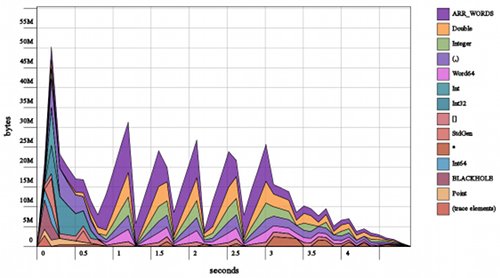
Heap profile (by type) of the Map-Reduce master running K-Means Single slave, clustering 50,000 points, 5 iterations
In this example the master process first creates a random set of 50,000 points, before running the K-means algorithm. This is the first peak. Then the other 5 peaks are the master node collecting data from the mapper nodes before reducing them locally.
Exercise 11. In the Work-Stealing example from Part 1 of this series the master reduces as it receives messages (
sumIntegers). Might you do something similar in the Map-Reduce master?
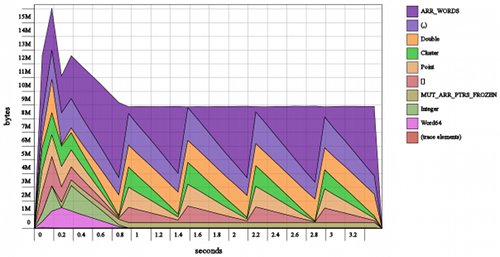
Heap profile (by type) of the Map-Reduce slave running K-Means Single slave, clustering 50,000 points, 5 iterations
In the slave node too, we clearly see the 5 iterations of the algorithm. At the start of each iteration the mapper node creates a list that associates points to clusters. Once the list is created, the list is serialized as a bytestring (purple section in the profile) and sent to the master node before the cycle starts again.
Exercise 12: (More technical) Why is the entire list created before it is serialized to a bytestring? (Hint: look up the
Binaryinstance for lists.) How might you change this so that the list is created lazily as it is serialized?
More information
We hope you've enjoyed this series (Parts 1, 2, 3, 4). For links to more information see the Cloud Haskell home page.
